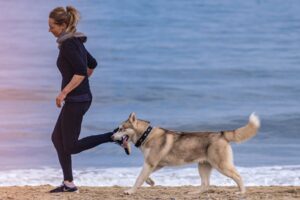What is training your animal like every day? Is it always fun? Is it always a walk in the park? Or do you feel overwhelmed by the goal of achieving “perfect dog mom of the year?” Maybe your life is so hectic that it makes it hard to fit training in? Maybe there is something else that makes it hard for you to take the things you know you should do with your dog, and put it into practice.
Like many of you, I have had pets my whole life. I had hamsters, gerbils, fish, mice, rats, cats, dogs, frogs, and probably more. But as a child, if I slipped up on something, or if I made a mistake, my parents would take care of it, and it didn’t usually bother me a lot. And when it did, I usually felt like it was not my fault entirely. Our dog didn’t receive training, and our yard remained unfenced because my parents wouldn’t pay for it. As a kid, there was really very little I could do about it. I just promised myself that when I was an adult, I’d do things right.
Training Sessions
Then, you become an adult. And with Adulting, comes a lot more stuff you didn’t plan for. Like me, you may have had some mental or physical health issues become more prominent. We have jobs and significant others; maybe even children and church or club responsibilities. There are dishes to do, laundry to fold, and mouths to feed. So, sometimes, even training for five minutes a day can seem INSANELY overwhelming, especially if you are neurodivergent like me, and find caring for your OWN needs somewhat frustrating.
That is all terribly disheartening, I know. Please, give yourself some slack! You have done your homework! You are here, reading the Pet Harmony Blog, and doing the best you can with the knowledge you have. We’re all busy, and many times the thing stopping us from being truly efficient in helping ourselves and our dogs is making the time to do so.

Break it Down
One of, if not THE most important part of any training plan is breaking things down into smaller chunks so that the learner can progress with as little stress as possible. So, if we’re talking about making daily training a realistic goal, and bringing training to real-life situations like Allie brought up in her past post, “Bridging the Gap Between Training Sessions and Real Life,” you need to TRAIN YOURSELF. That’s right. Sit down, and break the training plan into manageable chunks for yourself. Look at your goals, and don’t simply think about your pet; think about yourself. What parts of your training may not fit into your life the way you hope it might?
Is it hard to figure out when to practice your Flight cue with your reactive dog? What is preventing you from doing it? If it is time, think about your daily routine, or even your weekly schedule, and Think about times in your REAL life when you might need it, or when you will be reminded of it.
For example, I should trim my pets’ nails once a week. Unfortunately, in the past, I really only thought about it when Maya stepped on my foot, or when Sylphrena (my cat) scratched Maya when trying to play. So… not as often as I should. What I realized is that I could set up another cue for myself. I decided that every time I saw Maya’s claws, I would try to remind myself to clip her nails. Every morning, I sit on the couch for a bit to drink some water and take my medicine, and Maya loves to sit next to me and snuggle while I wake up. So, I put the nail clippers and an old peanut butter jar full of treats next to the couch. Now, we play the bucket game a few times a week to get her nails done.

Ways to Shape Your Own Behavior:
Making training a regular part of your life can be tricky. Forming new habits is hard. So, there are a few things you can do to help it be easier:
- Attach it to an existing behavior. For example, every day, you eat breakfast and feed your dog. If you do a bit of training with your dogs’ food or some tasty treats just BEFORE feeding them, then you will be more likely to remember.
- Replace an existing habit with this new one. Let’s say you have a dog who barks, lunges, and is generally no fun to walk. You can make your training session happen when you used to walk your dog. You can make training more tiring with play as a reward. Tug, fetch, or a flirt pole can work as an option for many dogs. OR, you can break up the training session with play breaks! So you might do sit, down, reward; stay, walk away, come back, treat. Then, release your dog and run around with them, or play a game with them. Having play as a part of your training sessions can be a rewarding option for many dogs and owners.

- Set reminders on your phone, or on other devices you see frequently. Make sure you set them to go off at a time that you should have time to do it.
- Track your sessions. This is a way to reinforce your future self!! It can help you feel accomplished, and I don’t know about you, but when I feel good about something, I tend to do it more. You could go as far as to make a training journal, or just write a checkmark on your calendar for each day you did train.
- Find a support system. Having someone to talk to about your goals helps to hold you accountable. You can find this with fellow dog owners, your trainer, supportive family members, or even online groups, like our Enrichment for Pet Behavior Issues Community on Facebook.
- Finally, find a way to make treats easily accessible. The more accessible they are, the easier it will be to start training in any moment. Use old peanut butter jars, or buy reusable jars and stash them in convenient places: by the door for your house if you have an excitable greeter, By the back door if you want to work on things outside, or even stash a few in your pockets. (Caution, please make sure that you take all the treats out of your pockets and stash your dirty clothes in a place that your pup cannot easily access to prevent them from chewing holes in all the places your treats have been!)
Now What?
Once you make training more of a part of who you are every day, I find that most people have an easier time incorporating training into their lives in a less formal manner. For example, now that I have treats next to my bed, I can toss her treats during a thunderstorm, or when a visitor knocks on my door at an unexpected time. These are not planned training sessions, but if I hadn’t set myself up for success by planning and practicing for them, then it would never have happened.
- Choose at least three places to keep treats handy for you. (But not your dog)
- Find a way to make training more habitual from either the list above, or something that you find works for you.
- Find a support system to keep you accountable.
- If you are finding it difficult to implement training into your life, consider hiring a qualified trainer, like setting up a session with us here at Pet Harmony.
- Or, come join us in the Beginning Behavior Modification course or the Roadmap to Behavior Solutions program.
